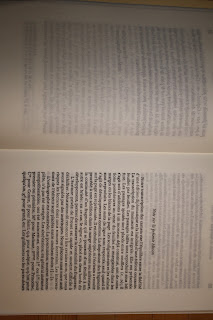Gallimard published a very handsome, very readable edition of Proust's Carnets or notebooks, in 2002. The ink on the page is darker than average and the font is clear and fairly large. But the text itself is unreadable, perhaps even an allegory of unreadability, even though it presents itself as genetic criticism. The book is divided up into four sections, each devoted to one of Proust's four notebooks and each introduced by an editor who also provides footnotes to the chapter. But the text of Prout's notes includes many sections with strike throughs in large swaths and notes that cross-reference a line or passage with a novel of Al la recherche. One has to ask: how does one "use" this rather Borgesian (linear yet labyrinthine) book? As a research "tool" it seems not to work very well since the notes do not fit into a genetic narrative of literary production: notes, first draft, published work. But read as a work of art, the edition of the notebook becomes really interesting. Proust's pages in print form start to look like French modern (20th ct) poetry that defines its poetics against the order of genetic criticism, progressively producing "finished" literature to a rougher and rougher draft of the poem that would have been, if finished, published. Facsimile editions are even more radically unreadable works of art in that they convert text into image. Next time: how genetic criticism defaults both to metaphors of birth and of death (skeleton).
Wednesday, January 25, 2012
Are textual critics more literary than the literature they edit?
Gallimard published a very handsome, very readable edition of Proust's Carnets or notebooks, in 2002. The ink on the page is darker than average and the font is clear and fairly large. But the text itself is unreadable, perhaps even an allegory of unreadability, even though it presents itself as genetic criticism. The book is divided up into four sections, each devoted to one of Proust's four notebooks and each introduced by an editor who also provides footnotes to the chapter. But the text of Prout's notes includes many sections with strike throughs in large swaths and notes that cross-reference a line or passage with a novel of Al la recherche. One has to ask: how does one "use" this rather Borgesian (linear yet labyrinthine) book? As a research "tool" it seems not to work very well since the notes do not fit into a genetic narrative of literary production: notes, first draft, published work. But read as a work of art, the edition of the notebook becomes really interesting. Proust's pages in print form start to look like French modern (20th ct) poetry that defines its poetics against the order of genetic criticism, progressively producing "finished" literature to a rougher and rougher draft of the poem that would have been, if finished, published. Facsimile editions are even more radically unreadable works of art in that they convert text into image. Next time: how genetic criticism defaults both to metaphors of birth and of death (skeleton).
Subscribe to:
Post Comments (Atom)













No comments:
Post a Comment